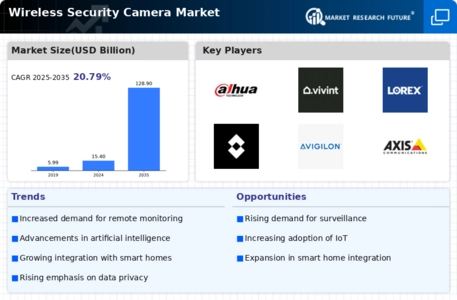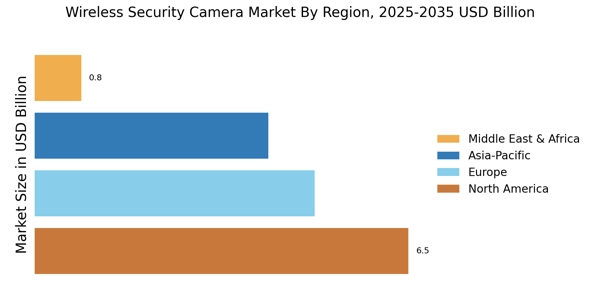Rising Security Concerns
The Wireless Security Camera Market is experiencing a surge in demand due to increasing security concerns among consumers and businesses alike. As crime rates fluctuate, individuals are more inclined to invest in surveillance solutions to protect their properties. According to recent data, the market is projected to grow at a compound annual growth rate of approximately 10% over the next five years. This growth is driven by the need for enhanced security measures, particularly in urban areas where crime rates tend to be higher. The proliferation of smart technologies has further fueled this trend, as consumers seek integrated solutions that offer real-time monitoring and alerts. Consequently, the Wireless Security Camera Market is positioned to expand significantly as more people recognize the importance of safeguarding their environments.
Technological Advancements
Technological advancements play a pivotal role in shaping the Wireless Security Camera Market. Innovations such as high-definition video quality, night vision capabilities, and cloud storage solutions have transformed the landscape of surveillance systems. The integration of advanced features, including motion detection and facial recognition, enhances the functionality of wireless cameras, making them more appealing to consumers. Market data indicates that the adoption of these technologies is expected to increase, with a notable rise in demand for smart cameras that can be controlled remotely via mobile applications. This trend suggests that as technology continues to evolve, the Wireless Security Camera Market will likely witness a shift towards more sophisticated and user-friendly products, catering to the needs of a tech-savvy consumer base.
Regulatory Compliance and Standards
Regulatory compliance and standards are increasingly influencing the Wireless Security Camera Market. Governments and regulatory bodies are establishing guidelines to ensure that surveillance systems meet specific safety and privacy requirements. This regulatory landscape is prompting manufacturers to innovate and adapt their products to comply with these standards. For instance, the implementation of data protection laws has led to a heightened focus on privacy features in security cameras. Market data reveals that companies investing in compliance are likely to gain a competitive edge, as consumers become more aware of their rights regarding data privacy. Consequently, the Wireless Security Camera Market is expected to evolve in response to these regulatory pressures, fostering a culture of accountability and transparency among manufacturers.
Increased Adoption of Smart Home Devices
The Wireless Security Camera Market is benefiting from the increased adoption of smart home devices. As households integrate various smart technologies, the demand for compatible security solutions has risen correspondingly. Data suggests that nearly 30% of households are now equipped with at least one smart device, creating a fertile ground for the growth of wireless security cameras. These devices not only provide security but also enhance the overall smart home experience by allowing users to monitor their homes remotely. The synergy between smart home systems and wireless cameras is likely to drive further innovation in the market, as manufacturers strive to create products that seamlessly integrate with existing smart home ecosystems. This trend indicates a promising future for the Wireless Security Camera Market as it aligns with the broader movement towards home automation.
Growing E-commerce and Online Sales Channels
The Wireless Security Camera Market is witnessing a transformation due to the growth of e-commerce and online sales channels. As consumers increasingly prefer to shop online, manufacturers and retailers are adapting their strategies to reach this audience effectively. Data indicates that online sales of security cameras have surged, with a significant portion of consumers opting to purchase these products through digital platforms. This shift not only broadens the market reach for manufacturers but also enhances consumer access to a diverse range of products. The convenience of online shopping, coupled with the availability of customer reviews and comparisons, is likely to drive further growth in the Wireless Security Camera Market. As e-commerce continues to expand, it may reshape the competitive landscape, compelling traditional retailers to enhance their online presence.


















Leave a Comment